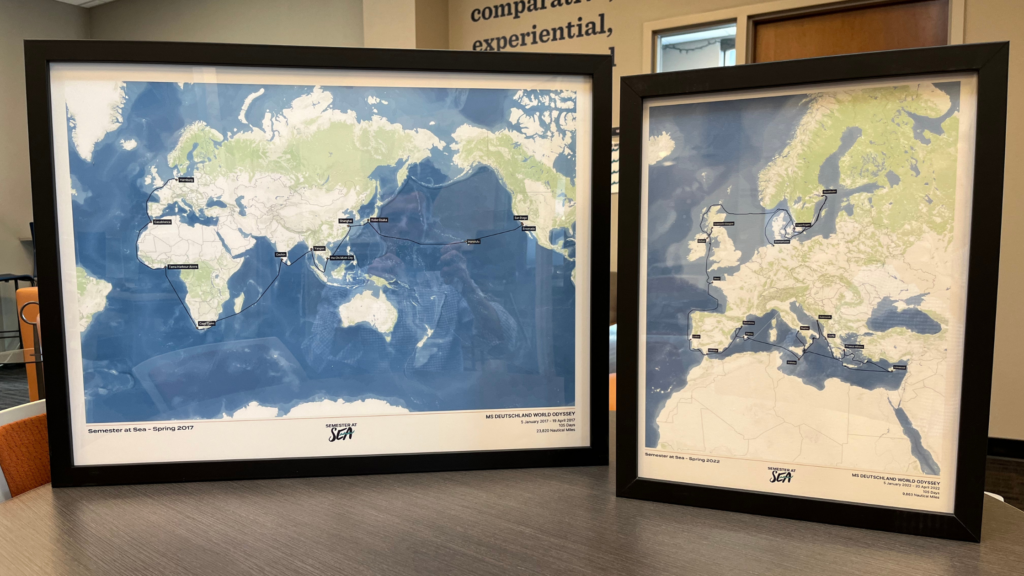The concept of a post-high school gap year originated in the UK in the 1960s, although the idea can be traced back to 13th century Europe, when young scholars would set off to explore the world and expand their knowledge. Gap years have long been considered a rite of passage for young people seeking personal and intellectual growth before continuing their formal studies or entering the workforce.
Though they have a long history, recent statistics show that gap years may be gaining in popularity. According to Inside Higher Ed, “While hard to track, there are estimates that 3 percent of freshmen take a gap year. Since the pandemic, internet searches for gap years have skyrocketed.”
So what goes into planning a gap year? Is it worth it to take time off between high school and college? It’s important to consider all the possibilities and implications as you plan your next step.
What Is a Gap Year?

A gap year is a period of time during which someone chooses to take a break from formal education in pursuit of travel, work, volunteerism, or any number of extracurricular activities. Gap years typically fall between high school graduation and before a student has been accepted into college, but can also refer to a break during, after, or between college, graduate school, or even jobs. Gap years can be shorter or longer than 12 months and allow individuals time to explore the world, gain life experience, and decide on their future educational or career path.
During a gap year, people often have the flexibility to embark on a wide range of endeavors, depending on their personal needs and goals. Common activities include traveling, exploring new places to live, pursuing important hobbies or projects, working to save money for college or other expenses, participating in work exchange programs, interning, volunteering, or building a professional portfolio.
Many people dedicate their gap year to reflection and self-discovery. This time between formal obligations allows one to step out of the traditional academic track, gain practical experiences, and better understand one’s passions and aspirations. By doing so, many people feel they can make more informed decisions about their next move.
People can organize their own gap year by planning and arranging the activities they wish to pursue, or participate in specialized gap year programs that provide structured opportunities and support.
Thinking of taking a gap year? Explore the Semester at Sea Gap Year Program Overview to discover the possibilities.
Who Should Take a Gap Year?

The best part about a gap year is that there is no right or wrong way to do it! Anyone can take a gap year at any time, though most formal gap year programs are geared toward students between high school and college. There are also programs that accept recent undergraduates and adult or “lifelong learners.”
Gap years can be especially valuable for:
- Recent high school graduates who are undecided about their college major or career path. A gap year allows young people to gain life experiences, explore different fields, and reflect on their interests and passions before committing to a specific academic or career track.
- Young people who want to practice independence. Taking a gap year often involves managing one’s own schedule, finances, and decision-making, which can foster personal growth and self-reliance.
- Individuals seeking a broader worldview. A gap year filled with new experiences provides opportunities to step out of one’s comfort zone, face new challenges, and learn valuable life skills while interacting with diverse communities.
- Anyone seeking like-minded peers. Gap year organizations can facilitate connections between peers who are also planning their next big life move, creating a supportive, lasting network of people with shared interests and aspirations.
No matter where you fall in your life’s journey, a well-planned gap year can be a transformative experience for anyone who seeks personal development, self-discovery, and a deeper understanding of their place in the world.
Pros of Taking a Gap Year

There are many reasons why young people around the world choose to take a gap year, since it offers a wide range of benefits.
New opportunities: Outside of the structure of school, a gap year gives you the chance to explore new opportunities and passions that may influence your future decisions.
Life skills: When you venture further afield, you can acquire essential life skills that might not be taught in a classroom, including adaptability, problem-solving, critical thinking, effective communication, and maintaining objectivity.
Personal growth: Planning your own gap year activities promotes independence, resourcefulness, confidence, and self-awareness.
Work experience: Without school-related obligations, young gap year takers can gain valuable work experience, enhancing their résumé and future career prospects.
Community contributions: Taking time to engage in volunteer or humanitarian efforts helps you make a positive impact in others’ lives.
Broader worldview: Encountering other cultures or life experiences when traveling broadens your perspective and fosters appreciation for diversity.
Extracurricular enrichment: Despite being a break from formal education, a gap year can still support your academic, professional, and personal development through classes or hands-on activities.
Recharge and renewal: After years of schooling, a gap year offers a well-deserved break to build energy and enthusiasm before embarking on further studies or work.
Save money: If you’re taking a year off to work before starting school again, you can save up to support future endeavors.
Real-world understanding: Drawing upon your prior knowledge in the real world helps you better understand classroom-based learning and its practical applications.
Expanded network: Depending on the kinds of activities you pursue, you’ll likely meet people from a wide range of backgrounds during your gap year. Meeting new people can expand your professional network, potentially opening doors for the future.
Clearer goals: Taking time off allows you to refine your goals for college, career, and life, so you can make more informed decisions when the time comes.
Potential Downsides to Taking a Gap Year
While the benefits far outweigh the negatives of taking a gap year, there are some potential drawbacks if the time is not used wisely.
Difficult transitions: After a gap year, some incoming college students may find it challenging to get back into the routine of studying. Some may even struggle to regain lapsed study habits or an interest in academics.
Feeling left out: Some young people might feel that they have fallen behind their peers who did not take a gap year, especially if their gap year experiences don’t directly align with their future academic or career goals.
Stalled momentum: College is not for everyone, and that’s perfectly fine. But if a college degree is part of your long-term career plan, taking time off can lead to a loss of momentum or enthusiasm for restarting your academic journey.
Cost: A gap year can be expensive, especially if it involves extensive travel or participating in specialized programs. Many programs do offer needs-based financial aid to cover all or part of the experience. Regardless, be sure to budget wisely so you have enough funds left over for your post-gap year plans.
Perceived lack of value: Some academic advisors, family members, or potential employers may not view gap years as valuable if the experiences don’t directly contribute to a résumé or a long-term career. While this view is entirely subjective, it may impact your prospects with certain schools or employers.
Lack of planning: Without proper planning, a gap year could feel like wasted time. Some people may be frustrated if they feel they aren’t using their time off effectively.
It’s essential for those considering a gap year to carefully weigh these potential downsides against the benefits and to plan their activities thoughtfully. A well-structured gap year with clear goals and objectives can avoid many of these potential drawbacks and make the experience more enriching and valuable in the long run.
If you’re considering taking a gap year, discuss the decision with your academic advisors, family, or mentors to ensure they understand the value and that the opportunity aligns with your personal and academic goals.
Taking a Gap Year During College

Though not as common as a gap year between high school and college, some college students choose to take time off in the middle of their studies. However, doing so can be more challenging compared to taking a gap year before starting college.
U.S. universities typically have strict scheduling requirements, and students are expected to be enrolled every semester to maintain their status as matriculating students. Many colleges also have specific policies around academic progress that require students to maintain a high GPA to retain their financial aid or other types of assistance.
While it may be difficult to take a traditional gap year in the middle of college, there are some circumstances where students can more easily take time off:
Transferring schools: If a student is transferring to a different college or university, they may be able to take some time off between institutions. However, it’s important to carefully review the specific policies and procedures for transferring credits and readmission beforehand.
Academic leave: Some universities have academic leave of absence policies that allow students to take a break from their studies for a specified period. During this time, students typically maintain their status as enrolled students, making it easier to return to the same institution at a later date.
Deferring enrollment: In certain cases, students may be able to defer their initial enrollment for a semester or a year. This is often granted for specific reasons, such as medical or personal circumstances. Deferring enrollment allows students to start college at a later date without having to reapply.
Students considering a gap year during college should have a thorough understanding of their university’s policies and procedures related to leaves of absence, readmission, and financial aid. Students should communicate with their academic advisors and relevant university offices to ensure they have a clear plan for their time off and a smooth transition back to their studies.
Key Considerations for Taking a Gap Year

To make the most of your gap year, keep several important considerations in mind:
Make sure everyone is on the same page. It’s essential for families of college-bound students to understand that a gap year is a valid and valuable option for growth. Taking time off doesn’t mean the student is stepping away from college altogether; rather, it offers them a chance to gain valuable experiences before continuing their formal education or entering the workforce.
Plan, plan, and plan some more. Planning ahead is crucial to ensure a meaningful and fulfilling gap year experience (and avoid wasting time). While you don’t need to plan your time down to the day, at least determine the types of activities you want to pursue, the best times of year for these activities, and your goals for the overall experience.
Consider travel implications. If you’re wondering whether to travel during your gap year, consider that it might not be as easy to travel extensively after college or once you are employed full-time. Take advantage of this opportunity to explore new places and cultures while you have the freedom to do so — it will no doubt be worth the expense.
Approach the experience with intention. Regardless of the reason for taking a gap year, view it as a valuable experience that can shape your future positively. Make the most of the time by choosing activities that align with your interests and goals.
Avoid procrastination. Don’t pursue a gap year simply to delay applying to schools or because someone else thinks it’s a good idea. Set clear goals and intentions around your decision.
Be prepared to reflect on your experience. Admissions officers and prospective employers will be interested to hear about what you did during your gap year and how your experiences impacted you. Being able to communicate the value of your gap year can showcase your growth and maturity.
How to Plan a Gap Year

A gap year can certainly be a transformative experience, but it requires thoughtful planning and intentionality. It should not be seen as a break from responsibilities, but as an opportunity to gain valuable experiences and personal growth before moving forward with your educational or career path.
Your planning process may vary, but here are some general steps to cover as you chart your course:
Plan ahead: Plan as much of your gap year as possible ahead of time, even starting before you’ve graduated high school. Map out the activities and experiences you want to have, and consider breaking up your time like a college semester to add structure to your year.
Research gap year programs: If you’re interested in participating in organized gap year programs, research organizations that specialize in arranging such experiences. Some are volunteer-based, others are academic in nature, and still others are designed for the pure joy of travel. Many programs charge fees to cover participants’ expenses, which adds to the overall cost of taking time off.
Explore funding options: Examine the costs associated with your time off. If you’re not already working or are on a budget, consider work exchange or service programs that might offer a stipend for living expenses.
Confirm college admission deferral: If you have already been admitted to college, check with the admissions office about their policy on deferring admission. Ensure that you understand the process and any deadlines for deferral — you don’t want to return from your gap year adventures only to find that your enrollment status has been suspended.
Check scholarship availability: If you have been awarded scholarships for college, inquire whether they are still available after a gap year. Some scholarships may have specific guidelines regarding deferral or gap years.
Secure references and resources for the future: Before embarking on your gap year, request any academic transcripts, references, letters of recommendation, or other resources from your former school. You will need them to apply for colleges and scholarships, and it’s best to have them ready when you return.
Stay organized: Keep track of important deadlines, documents, and contacts related to your gap year. Being organized will help ensure a smooth transition into and out of your time off.
Remain flexible: While planning is essential, be open to adapting your plans based on new opportunities or changing circumstances that may arise during your gap year.
When you embark on a gap year experience with Semester at Sea, you get to explore new cultures, experience daily life on board a ship, and even start to earn credits toward your future degree. Gap year travelers are a welcome addition to nearly every voyage, adding to the already diverse range of voyagers that attend our floating college.
We are committed to ensuring each voyager — whether they are a current college student, gap year voyager, or lifelong learner — has access to the resources they need to make the most of their experience. Connect with an admissions counselor today for more information.




